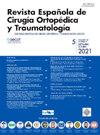[Artículo traducido] Modelo de simulación de retirada de yesos para el entrenamiento de residentes
Q3 Medicine
Revista Espanola de Cirugia Ortopedica y Traumatologia
Pub Date : 2025-06-09
DOI:10.1016/j.recot.2025.06.005
引用次数: 0
Abstract
Purpose
Complications from cast removal are infrequent but can cause permanent skin sequelae. Formal training in cast removal is limited during residency. This study aimed to develop a plaster cast removal simulation model for resident training.
Methods
Quasiexperimental study. A pediatric forearm phantom with temperature sensors was designed to simulate forearm cast removal. Six first-year orthopedic residents with no prior cast removal experience and two experts were evaluated. The residents underwent an initial evaluation, followed by an instruction session, and a final evaluation. Performance was assessed using a specific ratings scale (SRS), the Objective Structured Assessment of Technical Skills (OSATS) guideline, procedure time, and temperature measurement. Median scores with ranges were reported, and pre- and posttraining performances were compared using the Wilcoxon test. Experts scores were compared with resident scores using the Mann-Whitney test. The statistical significance was set at P < .05.
Results
Significant improvements in OSATS [(pre 22 points (range: 20-24); posttraining 25 (range: 25-28) (P = .03)] and SRS [pre 8.5 points (range: 7-9); post 10 points (range: 8-10) (P = .02)] were observed. No differences were found in temperature (P = .50) and procedure time (P = .09). When comparing residents’ post-training scores with those of experts, no significant differences were found in OSATS (P = .16), SRS (P = .11), temperature measurement (P = .50), or procedure time (P = .09).
Conclusions
The plaster cast removal simulation model proved to be an effective training tool for residents, enabling them to achieve expert-level competency. Significant improvements were observed in OSATS and SRS scores post-training, highlighting the positive impact of the intervention on this skill.
用于居民培训的石膏移除模拟模型
目的:脱模术后的并发症并不常见,但会引起永久性的皮肤后遗症。在住院医师期间,正式的脱模训练是有限的。本研究旨在为住院医师训练建立一个石膏移除模拟模型。MethodsQuasiexperimental研究。设计了一个带有温度传感器的儿童前臂假体来模拟前臂石膏的移除。6名没有拆除石膏经验的第一年骨科住院医师和2名专家进行了评估。住院医生接受了初步评估,随后是指导会议和最终评估。使用特定评分量表(SRS)、客观结构化技术技能评估(OSATS)指南、手术时间和温度测量来评估患者的表现。报告中位数得分和范围,并使用Wilcoxon检验比较训练前和训练后的表现。使用曼-惠特尼测试将专家得分与居民得分进行比较。统计学意义为P <; 0.05。结果患者OSATS评分(前22分,范围20 ~ 24分)显著提高;训练后25分(范围:25-28分)(P = .03)和SRS[训练前8.5分(范围:7-9分);10点后(范围:8-10)(P = .02)]。温度(P = 0.50)和手术时间(P = 0.09)无差异。住院医师培训后得分与专家比较,在OSATS (P = 0.16)、SRS (P = 0.11)、体温测量(P = 0.50)和手术时间(P = 0.09)方面均无显著差异。结论石膏石膏拆除模拟模型是一种有效的住院医师培训工具,可使住院医师达到专家级的技能水平。在培训后的OSATS和SRS评分中观察到显著的改善,突出了干预对这项技能的积极影响。
本文章由计算机程序翻译,如有差异,请以英文原文为准。
求助全文
约1分钟内获得全文
求助全文
来源期刊

Revista Espanola de Cirugia Ortopedica y Traumatologia
Medicine-Surgery
CiteScore
1.10
自引率
0.00%
发文量
156
审稿时长
51 weeks
期刊介绍:
Es una magnífica revista para acceder a los mejores artículos de investigación en la especialidad y los casos clínicos de mayor interés. Además, es la Publicación Oficial de la Sociedad, y está incluida en prestigiosos índices de referencia en medicina.
 求助内容:
求助内容: 应助结果提醒方式:
应助结果提醒方式:


